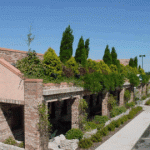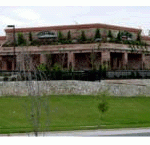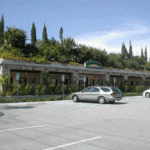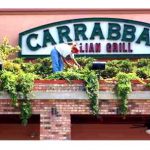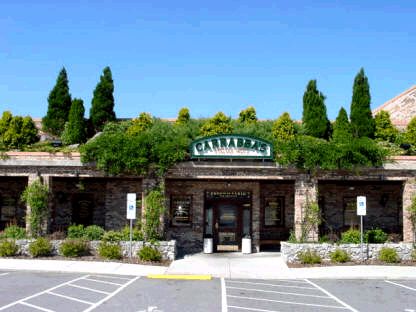
Additional Resources
As of 2006, Carrabba’s is no longer building the rooftop gardens on new restaurants. Ideally, we would appreciate including individual profiles for each restaurant, and encourage submittals from each. Read Linda S. Velazquez’s Exclusive entitled “Tuscan Skies Overhead” from October 6, 2003 on Greenroofs.com here. Read “Making the most of every space” in the July 10, 2004 The Free Lance-Star, by Cathy Jett here.
For more information about Carrabba’s and their philosophy for greening their environments, please visit www.carrabas.com or contact Andi Jacobs, Vice President, Director of Marketing & Advertising at AJacobs@carrabbas.com.
Brick walls, pergolas, Italian cypresses, junipers, arborvitae, flowering vines and perennials set on a gentle hill set against blue skies… Sounds like a southern Italian villa and the countryside of Tuscany, but actually this setting can be found on the roof of your neighborhood Carrabba’s Italian Grill. Orlando, Florida, was the first Carrabba’s to boast one, and from 1998 through 2005 every new Carrabba’s has been constructed with lush Italianate roof gardens. As of October 2003, over 70 of Carrabba’s’ 133 restaurants in 27 U.S. states were greened with 34 – 39 more expected through 2004. This Project Profile serves as the representative profile for all of the Carrabba’s Italian Grills, although there are currently over 100 built.In 1998 the Carrabba’s marketing team sought a way to differentiate and brand their Italian restaurants, and provide a distinctive sense of place. Evoking the desired feel resulted in recreating a bit of Tuscany on the roof, and the “second level plantings” concept – as they are referred to at Carrabba’s – was conceived. Respected Manhattan architect James Wines, known for his incorporation of nature and ecological approach, was hired to design the prototype roof garden scheme. The rigorous research, development and testing stage took about 18 months to complete and Wines’ original design was somewhat modified but basically remains true. Over time four other basic planting plans have evolved to best reflect and adapt to local conditions, including climate and architectural requirements, currently resulting in five protoptypes. In 2001 Carrabba’s revised the original size of the intensive roof garden from 1700 sf to the current 1000 sf. The estimation of 104,000 sf is cummulative for all, and is a conservative estimation based on 104 projects at 1,000 sf each.
The general design wraps around two sides of the restaurant, forming an L-shape planter approximately 110′ L x 9.3′ W, with a 4:1 slope ratio. The growth media depths slope from 4′ at the back to 16″ in the front, and the trees are anchored to the back walls for support. The “soil mix” has been engineered and adjusted for lightweight drainage properties and optimum local performance. The waterproofing membrane consists of the Bituthene? System 4000, followed by the Hydroduct drainage core and filter fabric, from the W R Grace Construction product line. A minimum 24-hour flood test of 4″ of water covering the entire roof precede all of the plantings to ensure water tightness. Initially a couple of leaks were reported, but minor adjustments eliminated the problem altogether, says a company spokesperson.Residents across the U.S. marvel at nature returning to the city. Small birds and butterflies abound, and surprisingly, geese are a common sight on many of Carrabba’s rooftops, with many nesting and laying eggs within the shrubs and trees. All of the geese are protected species, so they are guaranteed a safe haven in these often otherwise barren urban areas.In October, 2003 Keith Hurley, Vice President and Manager of the Landscape Installation Division of West Orange Nurseries in Winter Haven Florida managed the Carrabba’s roof gardens nationwide and stated that plant survivability is over 90%, due to great nursery stock, high maintenance standards and the experience of trial and error. The five planting prototypes reflect extreme climate conditions across the U.S., and all have thrived even in the heat of Texas and the cold of Boston and Salt Lake City. Learning from the challenge of overgrown bougainvillea in St. Petersburg, aggressive species have been replaced with more polite ones – both ornamental and indigenous to each region. Native plants are always incorporated into the signature Carrabba’s design that always includes Italian cypress trees. For example, central and south Florida roofs might also have sago palms, pigmy date palms, ixora, split-leaf philodendron, hibiscus, Texas sage, lantana, Confederate jasmine and mandevilla vines. The roofs are all fitted with drip irrigation providing low-volume watering, and plants are selected with relatively low maintenance qualities – slow growing plants and those with shallow root systems are preferred. Maintenance checks are performed once a month, with trimming kept to a minimum to allow for the desired free-flowing garden feel.
 Greenroofs.comConnecting the Planet + Living Architecture
Greenroofs.comConnecting the Planet + Living Architecture
